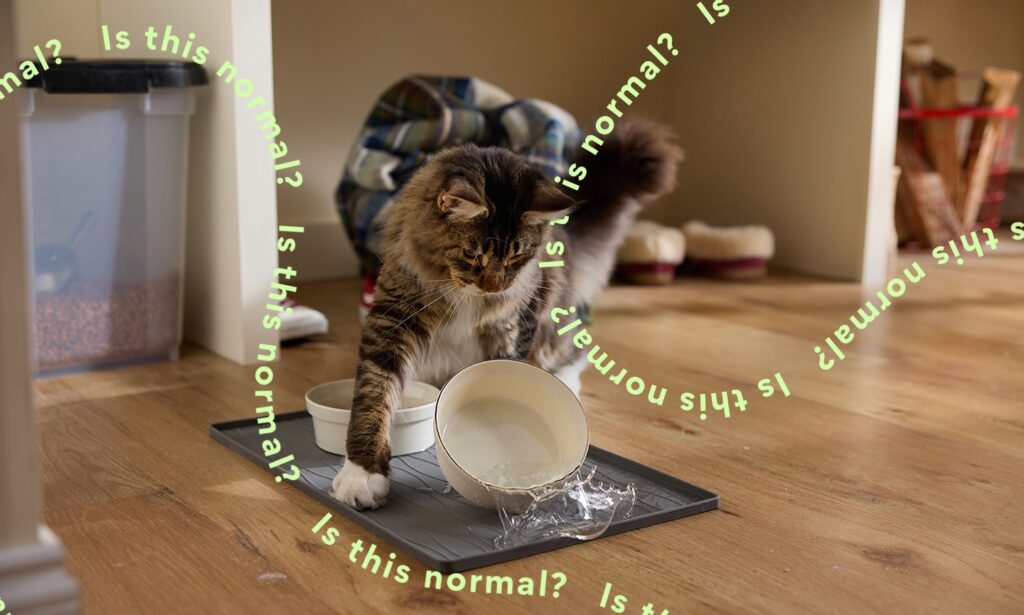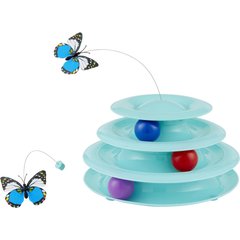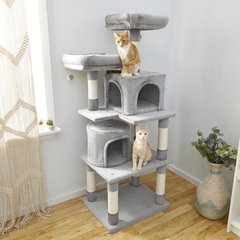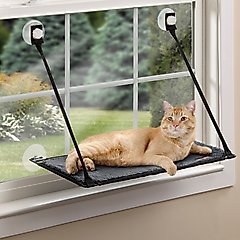My Cat Keeps Knocking Over Their Water Bowl. Is This Normal?

Photo by Chewy Studios
My cat will often hit his water bowl with his paw, almost as if he is trying to knock it over. Sometimes he actually does! Why is my cat knocking over his water bowl? Is this normal?
Although it can get a little messy at times, rest assured it’s usually normal cat behavior to knock over their water bowl. It’s likely satisfying some type of need. For example, they’re bored and it’s a fun way to pass the time, or they’re thirsty and want you to get them more water.
Reasons Why Cats Knock Over Their Water Bowl
“Cats knock over their water bowls for several reasons,” says Elizabeth Stanley-Reicherter, CBCC-Ka, CPDT-Ka, SBA, behavior manager at Animal Welfare Association in Voorhees, New Jersey. “Each cat may have a different reason for this behavior.” Some of the reasons might include:
It’s Fun
Some cats just have a good ole time trying to knock over their water bowl—it’s as simple as that. “Many cats have a fascination with water or a love-hate relationship with it!” explains Stephen Quandt, CFTBS, founder of Stephen Quandt Feline Behavior Associates, LLC in New York City. “They may knock it over, splash water or play with it because it’s fun.”
Stanley-Reicherter agrees that cats might get amused from knocking over their water bowl. She points out that some cats may see it as playing “a game.” A messy one, at that.
Cats May Have Evolved To Do This
This behavior may also be part of a cat’s evolution. “In nature, standing pools of water can become stagnant or biologically contaminated, so we believe that cats may have evolved to prefer moving water sources, as these are biologically safer,” explains Quandt. “For that reason, cats may play with their water to get it moving.”
It’s Reinforced Behavior
Another reason your cat may knock over their water bowl is because pet parents reinforce this behavior. In other words, they’ve learned knocking the bowl over gets them what they want, which may include:
- Attention
- More water
- Fresh water
“When the cat knocks over the water bowl, you refill it [with fresh drinking water] or you tell the cat, ‘No.’ The cat just gained attention or a refilled bowl of water, getting what she wanted,” explains Stanley-Reicherter. “Cats like fresh water, and they know when they knock the bowl over that you refill it,” she adds.
Quandt echoes this sentiment. “If you refresh the bowl after your Olympic diver has done his routine, he may have taught you to do this by upsetting the bowl.” How about that?

Is a Cat Knocking Over Their Water Bowl Ever a Cause for Concern?
If your cat is constantly knocking over their water bowl because they want more water and can’t seem to get enough to drink, you should contact your veterinarian. That’s because a cat drinking an excessive amount of water could indicate a health issue.
According to Emily Seidl, DVM, senior vet at Animal Welfare Association in Voorhees, New Jersey, health issues could include the following:
- Renal disease
- Liver disease
- Diabetes mellitus
- Hyperthyroidism
- Urinary tract diseases (stones or infections)
Does a Cat’s Age Play a Factor?
Kittens may be more prone to knocking over their water bowl than adult cats. That’s because kittens tend to be very playful, curious… and messy. “Everything is new to them, and because of all of these traits, many kittens may be more likely to play water sports!” Quandt jokes.
It may then become a learned behavior for some kittens, Stanley-Reicherter adds. “Once they figure out that this gets them attention, more water, and is just plain old fun, they will be more likely to repeat the behavior,” she says.
Stopping or altogether preventing this behavior when they are kittens can help ensure they don’t do it when they are older.
How To Stop a Cat From Spilling Their Water Bowl
While your cat knocking over their water bowl may seem cute the first few times, it can get old really quickly, especially if they’re creating puddles all over the floor.
Thankfully, there are some expert-approved ways cat lovers can help prevent their cat from spilling their water bowl.
Increase the Amount of Enrichment Around the Home
One way is to make your home is, well, less boring to cats. “Pet owners should increase the amount of enrichment their cats have,” says Stanley-Reicherter.
Here are some ways you can keep your feline friend stimulated around the home:
- Puzzle toys
- Clicker training
- Interactive toys
- Cat trees
- Window perches
- Hiding spots
“These are all good mental stimulation for your cat,” adds Stanley-Reicherter. She says that if your cat has other options for entertaining themselves, this may help reduce the likelihood of them knocking over their water bowl.
Recommended Products
Use a Cat Fountain
Pet water fountains are perfect for cats who like running water (we’re looking at you, cats who like to drink from the faucet) and typically knock over their water bowls.
“Cat water fountains are great for a lot of cats. Many like the moving water, and they won’t be able to turn it over very easily,” says Quandt. When choosing the right cat water fountain for you and your furry friend, Quandt recommends quiet and easy-to-clean ones.
Some Chewy cat parent favorites include:
Recommended Products
Buy a Heavier Bowl
Another way to help cut back on water spills is to change your cat’s water bowl. For instance, lightweight water bowls are more prone to getting knocked over once a cat starts to bat at them. To help prevent this, invest in heavier water bowls that aren’t so easy to topple. Doing so can stop cats from knocking them over, decreasing the amount of water spillage. If you notice your cat also does this with their cat food, go ahead and switch out their food bowl, too.
“Using a large, heavy, ceramic bowl, like a dog bowl, will prevent [your cat] from turning it over,” explains Quandt.
Stanley-Reicherter also recommends using a larger bowl with a wide, non-slip rubber base.
Some customers faves include:
Recommended Products
If those still don’t work, Dr. Seidl recommends a ceramic baking dish—like a casserole dish—”for those cats who really find it fun to tip.”
However, Quandt points out that this may not completely prevent splashing. For this, look for splash-proof and no-spill water bowls.
Tweak the Water Bowl Setup
If the water bowl is situated close to the wall, it may actually be helping your cat flip it over. “With many bowls, they need the wall to push it up to flip,” Stanley-Reicherter explains. She recommends placing the water bowl—and a heavy one at that—on a rubber mat in an open area to reduce the chances of your cat using the wall to aid in flipping the bowl over.
Change Out the Water More Often
You should be changing out your pets’ water daily. But if you find that is not enough for your cat, changing their water out more frequently may be in order. This is especially helpful for pet parents who have cats who are sticklers for clean water and are knocking over their water bowl because they want it refilled.
“Change your cat’s water at least twice a day,” says Stanley-Reicherter. “By changing the water, you should provide your cat with the fresh water they desire.”
Although they can’t speak “human,” cats have many interesting ways of communicating with us through their behavior and body language. Read our guide to cat body language to better understand what your cat is trying to tell you.



















